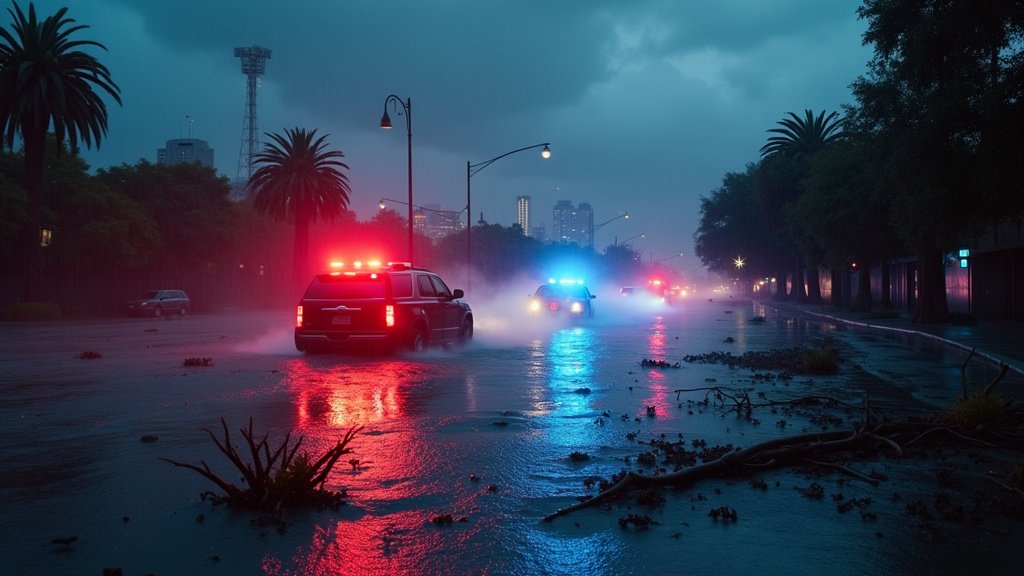Southern California Storm Unleashes Torrential Rain, Sparks Widespread Flooding and Debris Flow Warnings
Los Angeles, CA – A powerful Southern California storm, driven by an intense atmospheric river, swept across the region, delivering several inches of rain and triggering widespread flood advisories. The deluge, which intensified throughout Saturday, caused hazardous conditions, leading to road closures, debris flow warnings, and prompting evacuation orders in vulnerable areas, particularly those near recent burn scars following the Southern California storm.
The atmospheric river storm system brought substantial rainfall, with totals ranging from 2 to 6 inches across much of Southern California by Saturday evening. Foothill areas experienced even higher accumulations, exceeding 4 inches. This Southern California storm followed earlier rainfall in Northern California and marked a substantial increase in precipitation for the region. Forecasts indicated that Los Angeles rain could be on track for its wettest November in 40 years, potentially receiving a fifth of its annual average rainfall by the weekend’s conclusion. Downtown Los Angeles alone recorded 1.74 inches of rain between Friday afternoon and Saturday from this potent Southern California storm.
Flooding and Debris Flows from the Southern California Storm
The heavy rainfall from this Southern California storm intensified concerns over flash flood risk and dangerous debris flows, especially in areas recently impacted by wildfires. In response, evacuation orders were issued for communities situated near burn scars from fires earlier in the year. While some of these warnings were later lifted, others remained in effect until Sunday evening, particularly for established burn scar locations. Mayor Karen Bass of Los Angeles highlighted the critical danger of debris flows, confirming that warnings were active in and around recent burn scar zones due to the significant Southern California storm.
The National Weather Service issued flash flood warnings for several parts of Los Angeles County, anticipating rainfall rates as high as one inch per hour in urban centers like Burbank, Griffith Park, North Hollywood, and Downtown Los Angeles. Flood advisories were also implemented across Los Angeles and Ventura counties, underscoring the broad California storm impact. The rapid and substantial runoff generated by the intense rainfall fueled widespread Southern California flooding concerns. The threat of debris flows—rapid landslides composed of mud and debris moving at speeds up to 35 mph—posed a severe risk, with the potential to inundate homes and sweep away vehicles during this Southern California storm.
Infrastructure and Transportation Disruptions During the Southern California Storm
The storm’s intensity resulted in numerous transportation disruptions. Key roadways such as Topanga Canyon Boulevard, between Pacific Coast Highway and Grand View Drive, were shut down due to minor debris flows. In Huntington Beach, Pacific Coast Highway experienced road closures between Warner Avenue and Seapoint Street because of inundating floodwaters. Minor flooding also impacted freeways within Los Angeles, including sections of the 60 Freeway. The 101 Freeway in Ventura saw reports of mudflow on its northbound lanes near La Conchita, a common concern with atmospheric river storms. Further north, in Santa Clarita, sections of Highway 14 were obstructed by rocks and debris, with large boulders falling onto the roadway due to the extreme weather from the Southern California storm.
Urban areas were not spared, with at least 58 trees reportedly downed in Burbank alone. In Altadena, a fallen tree crushed an SUV, and similar incidents in the Hollywood Hills led to power outages. The storm also contributed to the formation of several sinkholes along Edgewood Drive in South Pasadena due to underlying infrastructure failures, exacerbated by the heavy rainfall.
Community Preparedness for the Southern California Storm and its Aftermath
In anticipation of the severe weather from this Southern California storm, authorities implemented several precautionary measures. Evacuation orders were issued for areas deemed at higher risk, and temporary sandbag distribution sites were established in fire-impacted zones to assist residents in preparing for potential debris flows, a critical element of community preparedness. For those displaced by evacuations, three shelters were opened within Los Angeles County.
The National Weather Service strongly advised residents to remain vigilant for changing conditions, debris flows, and potential southern california flooding. They urged the public to avoid non-essential travel and to never attempt to drive through flooded roadways, emphasizing that most flood-related fatalities occur within vehicles, especially during an intense atmospheric river storm. This emphasis on community preparedness is vital for any major Southern California storm.
This significant storm event has underscored the persistent risks associated with severe weather in Southern California, particularly in wildfire-affected regions. The incident highlights the critical importance of robust preparedness strategies and timely responses from both governmental agencies and the community in the face of a powerful Southern California storm and its resulting California storm impact.





